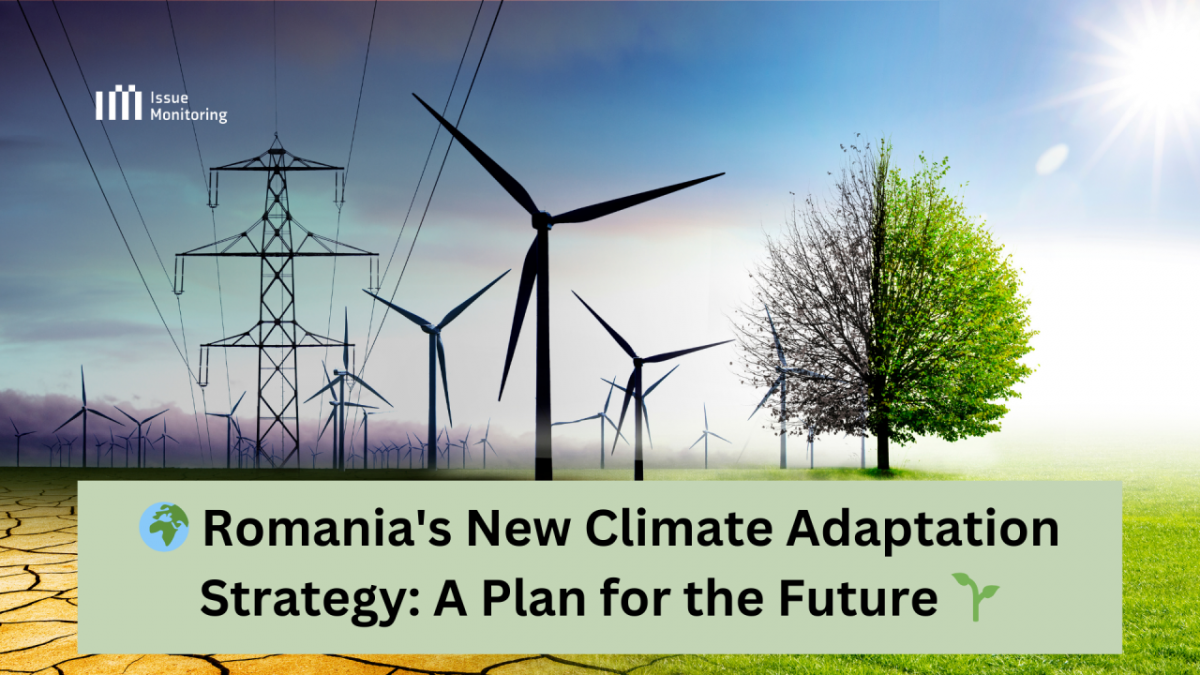
Article written by Eusebiu Valentin Stamate, Senior Public Policy Analyst @Issue Monitoring
In response to the escalating impacts of climate change, Romania has taken a significant step by approving last week its new National Strategy on Adaptation to Climate Change for the period 2024–2030, with a forward-looking perspective towards 2050. This strategy was published in the Official Gazette yesterday and emerges after nearly two years of public debate, consultations with stakeholders and consideration of Romania’s unique climate challenges.
The urgency of this strategy is underscored by the extreme temperatures Romania experienced this past summer, which brought record heatwaves and severe drought conditions. These events not only impacted agriculture and water resources but also posed serious health risks to vulnerable populations. Such climate extremes are becoming more frequent and intense, highlighting the pressing need for a cohesive and strategic approach to build resilience across all sectors of the economy and society.
The adoption of this strategy signals Romania’s recognition of the need to prepare systematically for future climate impacts. It sets the groundwork for transforming how the country manages its natural resources, protects vulnerable populations, and ensures the long-term sustainability of its economic development. This strategy is not just a policy document; it is a roadmap that will guide Romania through the complex and evolving landscape of climate adaptation.
Objectives
The strategy outlines several key objectives aimed at enhancing Romania’s resilience to climate change. These objectives are designed not only to address immediate climate challenges but also to lay the groundwork for long-term sustainability. The main objectives include:
- Strengthening Resilience: This involves fortifying critical infrastructure, natural ecosystems, and socio-economic systems to better withstand and recover from climate-related risks. The strategy places particular emphasis on making these systems robust against extreme weather events, such as floods, droughts, and heatwaves.
- Reducing Vulnerability: The strategy focuses on key sectors—agriculture, water resources, energy, public health and transport—that are particularly vulnerable to climate impacts. By implementing sector-specific measures, the strategy aims to reduce the risks associated with climate variability and extreme events, thus safeguarding livelihoods, food security, public health, and the continuity of essential services like transportation.
- Integrating Climate Adaptation: A crucial objective is to integrate climate adaptation measures into national and local policy frameworks. This integration ensures that all levels of governance, from municipalities to national agencies, work cohesively towards common climate goals.
- Promoting Sustainable Development: The strategy aligns with broader sustainable development goals, ensuring that economic growth goes hand in hand with environmental protection. This approach supports Romania’s contribution to global climate targets, particularly those outlined in international agreements like the Paris Agreement.
Directions of Action
To achieve these objectives, the strategy proposes specific actions across multiple sectors, each tailored to address the unique challenges posed by climate change:
- Water Resources: The strategy calls for the modernization of the water infrastructure, including the construction of new reservoirs, improvement of existing dams and the implementation of advanced water management systems. These actions are crucial for ensuring water availability during periods of extreme weather.
- Agriculture: Recognizing the vulnerability of the agricultural sector, the strategy promotes climate-smart practices such as the development of drought-resistant crops, precision farming techniques and improved irrigation efficiency. These measures are essential for maintaining agricultural productivity in the face of climate change.
- Energy: The strategy emphasizes the transition to renewable energy sources, such as wind, solar, and hydroelectric power, to reduce reliance on fossil fuels. Additionally, it calls for the strengthening of the energy grid’s resilience to climate impacts, ensuring a stable energy supply even during extreme weather conditions.
- Public Health: The strategy includes comprehensive measures to enhance the healthcare system’s capacity to manage climate-related health issues. This involves improving early warning systems for heatwaves, strengthening the response to climate-related diseases and increasing public awareness about these risks. The goal is to protect the most vulnerable populations, particularly the elderly and those with pre-existing health conditions.
- Transport: The strategy addresses the resilience of transport infrastructure by reinforcing roads, railways and bridges to withstand extreme weather events. It also promotes the shift towards low-emission and electric vehicles, contributing to a reduction in the transport sector’s carbon footprint and enhancing overall sustainability.
- Data and Monitoring: The strategy recognizes the importance of accurate and timely data. It plans to enhance platforms like RO-ADAPT for continuous monitoring and assessment of climate risks, providing decision-makers with the information needed to protect Romania’s environmental future.
- Institutional Coordination: The strategy emphasizes the need for collaboration among government agencies, local authorities, the private sector and civil society. This coordination is vital to ensuring that climate adaptation measures are effectively implemented across the country.
Alignment with EU Climate Goals
Romania’s strategy is closely aligned with the European Union’s broader climate and sustainability objectives, ensuring that national efforts contribute to EU-wide goals:
- Supporting the European Green Deal: The strategy supports the European Green Deal’s goal of making Europe the first climate-neutral continent by 2050. Romania’s focus on renewable energy, energy efficiency and sustainable agriculture aligns with the Green Deal’s targets for reducing greenhouse gas emissions.
- Compliance with the EU Climate Law: Romania’s strategy reflects its obligations under the EU Climate Law, which binds member states to collective emissions reduction targets. By integrating climate adaptation into national policies and enhancing infrastructure resilience, Romania contributes to the EU’s climate neutrality goals.
- Contributing to the EU Adaptation Strategy: The strategy aligns with the EU Strategy on Adaptation to Climate Change, which calls for smarter, faster and more systemic adaptation efforts across Europe. Romania’s approach includes prioritizing data-driven decisions and enhancing systemic resilience across critical sectors.
- Integration with the EU’s Sustainable Development Goals (SDGs): The strategy supports the EU’s commitment to the United Nations Sustainable Development Goals (SDGs), particularly those related to climate action, clean water and affordable energy. Romania’s climate adaptation efforts are part of a broader strategy to promote sustainable development in line with EU priorities.
- Access to EU Funding and Support: By aligning with EU climate policies, Romania is well-positioned to access various EU funding mechanisms, which will be crucial for supporting the implementation of climate adaptation projects.
Next Steps
With the strategy now officially adopted, the next steps are crucial:
- Development of Action Plans: Ministries and local authorities will need to develop detailed action plans to translate the strategy’s broad objectives into concrete projects and initiatives across sectors.
- Securing Funding: It will be essential to identify and secure funding from both national budgets and EU resources to support the strategy’s implementation, particularly for large-scale infrastructure projects and technological upgrades.
- Monitoring and Evaluation: Establishing robust monitoring frameworks will be necessary to track progress against the strategy’s objectives. Regular evaluations will allow adjustments to be made as needed, ensuring that the strategy remains responsive to emerging climate risks.
- Stakeholder Engagement: Continuous engagement with stakeholders, including the private sector, civil society and local communities, will be key to maintaining momentum and ensuring that the strategy is effectively implemented at all levels.
- Periodic Reviews: The strategy includes provisions for periodic reviews and updates, ensuring that it remains aligned with evolving climate science, EU policies and national priorities.
Conclusion
Romania’s new strategy marks a pivotal moment in the country’s approach to climate change, laying out a path towards resilience and sustainability. The adoption of this strategy is a first step, but its success will depend on how effectively it is implemented across all sectors of society.
As Romania embarks on this journey, the challenge will be to translate these ambitious plans into tangible actions that protect both people and ecosystems from the growing risks of climate change. The strategy’s alignment with EU goals and access to EU funding opportunities provide a strong foundation, but continuous effort, collaboration and adaptation will be key to its success.
This is an exciting and critical time for Romania, as the country positions itself to not only adapt to the changing climate but also to thrive in a more sustainable and resilient future. The progress made in the coming years will be closely watched, as it will set the tone for Romania’s long-term climate resilience.
Do you need a smarter solution to keep up with legislation, save time, and never miss an important update? Discover Issue Monitoring!


